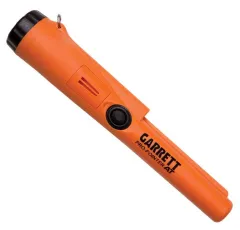Is a pinpointer necessary?
For those who want to do more than just a "hobby" and take a more professional approach, a pinpointer is the constant companion of a prospector. Searching the excavation hole or the excavation is much easier and quicker, and you also avoid damaging the object found.
How does a pinpointer work?
The technology of the pinpointer is based on the principle of electromagnetic induction. When the pinpointer is switched on, it generates an electromagnetic field around its tip. When this field hits a metal object, an electric current is generated in the metal, which is detected by the pinpointer.
The pinpointer has an electronic circuit that analyses this electric current and emits an audible or visual signal to alert the user that they are approaching the target. Normally, the signal becomes stronger the closer the pinpointer gets to the target.
Most pin pointers also have a feature that allows the user to adjust the sensitivity of the device to increase or decrease the range of the signal. This allows the user to narrow down the search area and locate the target more precisely.
Overall, the pinpointer's technology is relatively simple but effective. It is a useful addition to any Metalldetektoren to facilitate the search for buried objects.
Metalldetektoren Pinpointers consist of an electronic circuit, usually battery-powered, and a search coil through which a low-frequency alternating current flows and whose magnetic field is designed to reach as far as possible. The shape of the coil in pin pointers is elongated (cylindrical coil) and the electronics and coil are connected to each other by a cable and usually housed in a rod-shaped casing.

Magnetic field of a cylindrical coil (cross-section). The wire windings are marked with "×" (current flows into the image plane) and "-" (current flows out of the image plane).
Source: By Geek3 - Own workThis plot was created with VectorFieldPlot, CC BY-SA 3.0
Why is a pinpointer needed?
The pinpointer is the most important aid for the explorer, in addition to the Grabungswerkzeuge, as it not only saves time before or during digging, but can also ensure that valuable finds such as coins, brooches, medals, jewellery and other precious metals are not damaged during recovery.
After locating the object found, which is usually covered by stones and roots that interfere with the recovery of the find, the pinpointer is used. In general, these devices are not equipped with a discriminator or manual ground adjustment. These functions are only required for general find localisation with the actual Metalldetektoren. Pinpoint probes are available in very different versions. They range in price from €50 to around €200. As a rule, you won't be happy for long with devices costing less than €50. We advise against "simple line detectors" from the DIY store or from the "Far East".




